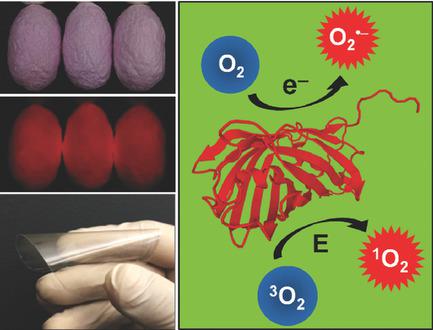Our official English website, www.x-mol.net, welcomes your
feedback! (Note: you will need to create a separate account there.)
Green‐Light‐Activated Photoreaction via Genetic Hybridization of Far‐Red Fluorescent Protein and Silk
Advanced Science ( IF 14.3 ) Pub Date : 2018-03-12 , DOI: 10.1002/advs.201700863 Jung Woo Leem 1 , Jongwoo Park 2 , Seong-Wan Kim 2 , Seong-Ryul Kim 2 , Seung Ho Choi 1 , Kwang-Ho Choi 2 , Young L Kim 1, 3, 4
Advanced Science ( IF 14.3 ) Pub Date : 2018-03-12 , DOI: 10.1002/advs.201700863 Jung Woo Leem 1 , Jongwoo Park 2 , Seong-Wan Kim 2 , Seong-Ryul Kim 2 , Seung Ho Choi 1 , Kwang-Ho Choi 2 , Young L Kim 1, 3, 4
Affiliation

|
Fluorescent proteins often result in phototoxicity and cytotoxicity, in particular because some red fluorescent proteins produce and release reactive oxygen species (ROS). The photogeneration of ROS is considered as a detrimental side effect in cellular imaging or is proactively utilized for ablating cancerous tissue. As ancient textiles or biomaterials, silk produced by silkworms can directly be used as fabrics or be processed into materials and structures to host other functional nanomaterials. It is reported that transgenic fusion of far‐red fluorescent protein (mKate2) with silk provides a photosensitizer hybridization platform for photoinducible control of ROS. Taking advantage of green (visible) light activation, native and regenerated mKate2 silk can produce and release superoxide and singlet oxygen, in a comparable manner of visible light‐driven plasmonic photocatalysis. Thus, the genetic expression of mKate2 in silk offers immediately exploitable and scalable photocatalyst‐like biomaterials. It is further envisioned that mKate2 silk can potentially rule out hazardous concerns associated with foreign semiconductor photocatalytic nanomaterials.
中文翻译:

通过远红荧光蛋白和丝的基因杂交进行绿光激活光反应
荧光蛋白通常会导致光毒性和细胞毒性,特别是因为一些红色荧光蛋白会产生并释放活性氧 (ROS)。 ROS 的光生成被认为是细胞成像中的有害副作用,或者被主动用于消融癌组织。作为古老的纺织品或生物材料,蚕丝可以直接用作织物或加工成材料和结构以承载其他功能纳米材料。据报道,远红荧光蛋白(mKate2)与丝的转基因融合为ROS的光诱导控制提供了光敏剂杂交平台。利用绿光(可见光)激活,天然和再生的 mKate2 丝可以以与可见光驱动的等离子体光催化类似的方式产生和释放超氧化物和单线态氧。因此,mKate2 在丝中的基因表达提供了可立即利用且可扩展的类光催化剂生物材料。进一步设想,mKate2 丝可以潜在地排除与外国半导体光催化纳米材料相关的危险问题。
更新日期:2018-03-12
中文翻译:

通过远红荧光蛋白和丝的基因杂交进行绿光激活光反应
荧光蛋白通常会导致光毒性和细胞毒性,特别是因为一些红色荧光蛋白会产生并释放活性氧 (ROS)。 ROS 的光生成被认为是细胞成像中的有害副作用,或者被主动用于消融癌组织。作为古老的纺织品或生物材料,蚕丝可以直接用作织物或加工成材料和结构以承载其他功能纳米材料。据报道,远红荧光蛋白(mKate2)与丝的转基因融合为ROS的光诱导控制提供了光敏剂杂交平台。利用绿光(可见光)激活,天然和再生的 mKate2 丝可以以与可见光驱动的等离子体光催化类似的方式产生和释放超氧化物和单线态氧。因此,mKate2 在丝中的基因表达提供了可立即利用且可扩展的类光催化剂生物材料。进一步设想,mKate2 丝可以潜在地排除与外国半导体光催化纳米材料相关的危险问题。










































 京公网安备 11010802027423号
京公网安备 11010802027423号